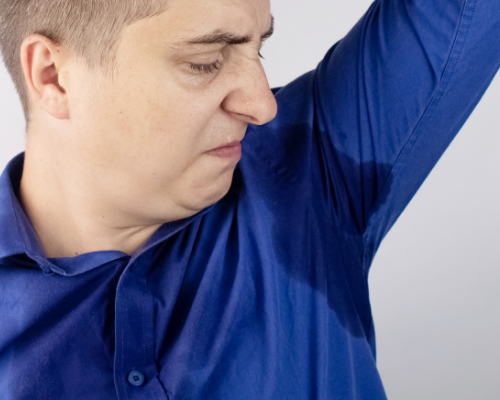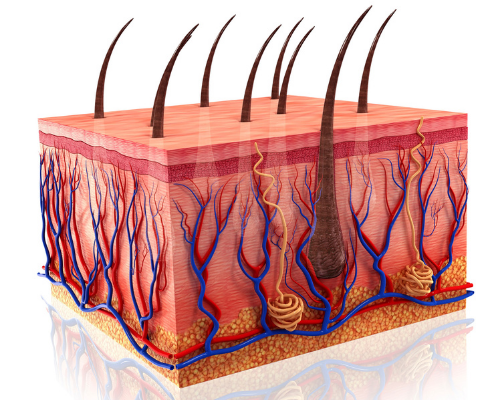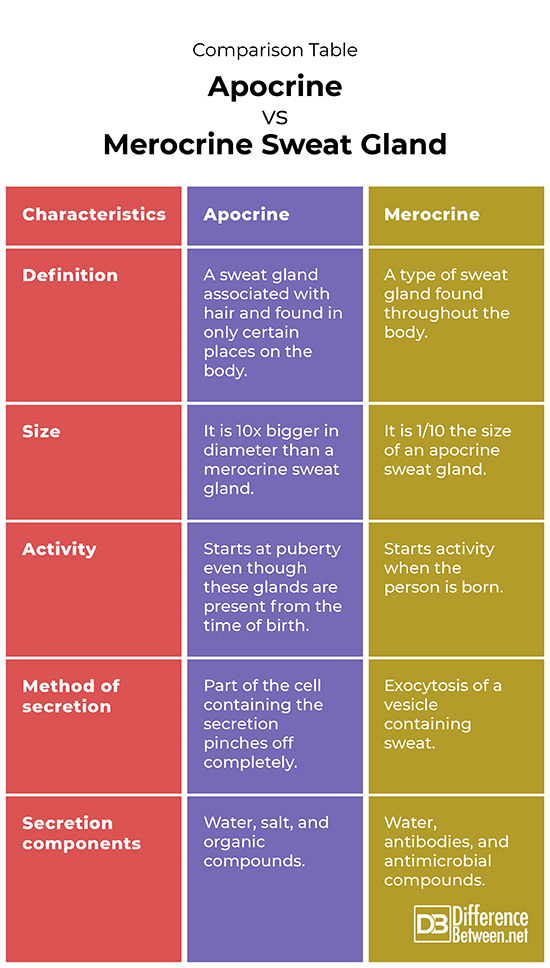Difference Between Apocrine and Merocrine Sweat Glands
Apocrine sweat glands are found associated with hair follicles and only become active at puberty. Merocrine sweat glands are found throughout the skin and produce a watery sweat from birth.

What is Apocrine Sweat Gland?
Definition:
An apocrine sweat gland is a type of gland that is associated with a hair follicle and that produces a type of sweat that tends to have an odor.
Structure:
These glands are always associated with hair follicles. An apocrine gland has a coiled structure that secretes sweat and then a duct through which the secretion passes. The duct opens into the hair follicle.
Location:
The apocrine glands are found mostly in the armpits, in the genital area, and by the nipples. They are also found in the ear canal and on the eyelids. These glands are found quite deep in the skin in the dermis or subcutaneous fat layer. These sweat glands are less abundant than the merocrine glands since they are only found in certain parts of the human body.
Secretion method and function:
The apocrine secretions are released when the top part of the cell disintegrates. Apocrine gland secretions are thought to possibly be pheromones that are involved in sexual function. This is the function of these glands in the lower mammals, and may play a similar role in humans. More research, however, is needed on the function of these glands in humans. The apocrine sweat glands do also secrete sweat when a person feels strong emotions such as fear and anxiety.
Pathological conditions:
Apocrine bromhidrosis is when too much sweat is secreted from these glands resulting in unpleasant body odor. Apocrine chromhidrosis is a disorder in which colored sweat is produced, but this is a rare disorder.

What is Merocrine Sweat Gland?
Definition:
These glands occur throughout the body but are more concentrated on the palms of the hand and soles of the feet.
Structure:
A merocrine sweat gland is comprised of a straight section and a secretory coiled part. These particular sweat glands are much smaller than apocrine sweat glands, being only about 1/10 the size.
Location:
The merocrine glands are widespread and found in the skin throughout the body with the highest concentrations in some areas such as the soles of the feet. The glands are located in the dermis and hypodermis of the skin, and unlike the apocrine sweat glands are not associated with hair follicles. This means that these glands open directly onto the epidermis of the skin, unlike the apocrine glands.
Secretion method and function:
Apocrine glands secrete sweat formed in vesicles by a process of exocytosis. Exocytosis is when a vesicle containing a substance fuses with the cell membrane and then opens to the external environment to release its contents. The sweat produced by the merocrine sweat glands helps the body to cool down in hot conditions. This thermoregulatory function is controlled by the central nervous system, which at higher temperatures triggers the secretion and release of sweat from the merocrine glands. The sweat helps the body cool down as it evaporates from the skin.
Pathological conditions:
Primary focal hyperhidrosis is when the merocrine sweat glands are overly active, producing too much sweat. This can cause clammy hands and feet but also increases the risk of skin infections because the moist environment attracts bacterial and fungal overgrowth.
Difference between Apocrine and Merocrine sweat glands
Definition
An apocrine sweat gland is a sweat gland associated with hair and found in only certain parts of the body. A merocrine sweat gland is a type of gland that is found throughout the body.
Size
The apocrine gland is about 10 times larger than the merocrine gland. The merocrine gland is about 1/10th the size of the apocrine gland.
Activity
The activity of an apocrine gland begins at puberty even though these glands are present from the time of birth. The activity of a merocrine gland begins at birth.
Method of secretion
Apocrine sweat gland secretion involves the part of the cell containing the secretion pinching off completely from the rest of the cell. Merocrine sweat gland secretion involves exocytosis of vesicles containing the sweat.
Secretion components
The components of apocrine sweat gland secretions include salt ,water, and organic compounds. The components of merocrine sweat gland secretions include antibodies, water, and antimicrobial compounds.
Table comparing Apocrine and Merocrine sweat glands

Summary of Apocrine Vs. Merocrine sweat glands
- Apocrine and merocrine sweat glands both occur in the skin.
- Apocrine secretion is different from merocrine secretion.
- Merocrine sweat glands are active at birth while apocrine glands only become active at puberty.
FAQ
What are the main differences between merocrine, holocrine, and apocrine methods of secretion?
Merocrine glands secrete substances by exocytosis. In the case of holocrine secretion, the cell membrane disintegrates and the cell is destroyed in the process of secretion of products formed in the cytoplasm. In apocrine glands, secretion is by part of the cell that contains the secretory products pinching off from the rest of the cell.
What is the main difference between eccrine and apocrine glands?
Eccrine glands open up directly onto the epidermis of the skin while apocrine glands open up into hair follicles, which then open onto the epidermis.
- Difference Between Rumination and Regurgitation - June 13, 2024
- Difference Between Pyelectasis and Hydronephrosis - June 4, 2024
- Difference Between Cellulitis and Erysipelas - June 1, 2024
Search DifferenceBetween.net :
Leave a Response
References :
[0]Murphrey, Morgan B., Anthony O. Safadi, and Tanvi Vaidya. "Histology, apocrine gland." Statpearls (2018).
[1]Wilke, Katrin, et al. "A short history of sweat gland biology." International journal of cosmetic science 29.3 (2007): 169-179.
[2]William Montagna. “Human skin”. Encyclopedia Britannica, 2021, https://www.britannica.com/science/human-skin
[3]Image credit: https://www.canva.com/photos/MAEmPp2gmcY-the-man-shows-his-sweaty-armpits-to-the-camera-close-up-of-sweat-drops-gland-problems-hyperhidrosis-increased-sweating-anhidrosis-concept-of-treatment-for-violations-of-the-mechanisms-secretion-/
[4]Image credit: https://www.canva.com/photos/MADmTMhomho--human-skin/
